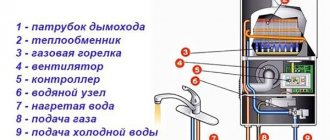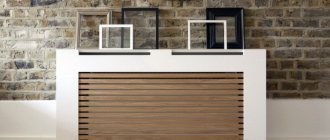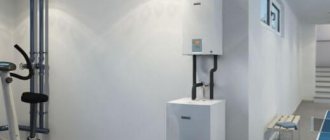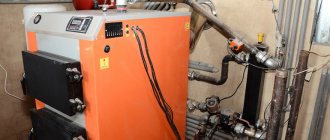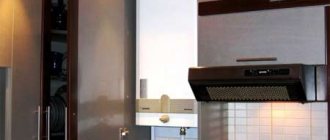It often happens that hot water somehow suddenly disappears. You came home from work, turned on the tap, and nothing happened.
And you need to put yourself in order. And the fuss with pots and running around with basins begins, a waste of energy and time.
If such situations happen frequently in your region or home, it’s time to buy yourself a water heater. In this article we will answer in detail the question: how to choose a suitable water heater for your home, cottage or apartment.
Page navigation:
Main types
Before choosing a water heater, you need to determine your needs and think about what it will be used for.
Main types;
Electric and gas,
Cumulative and flow-through.
As well as indirect heating devices
Instantaneous water heaters.
From network 220
The operating principle of a flow-type water heater.
Cold water flows through the water heater and its temperature rises under the action of the heating element (heating element). The power of the heating element is from 3 to 27 kW. Devices with a power of up to 8 kW are designed to operate from a single-phase network. Hot productivity, from 2 to 6 l/min.
Instantaneous water heaters are divided into pressure and non-pressure. The first ones are built into the riser and supply liquid to several points.
Non-pressure units are installed as close as possible to the point of water intake. The exit is a tap or watering can on a flexible hose.
An instantaneous electric water heater is a common and effective way to obtain hot water in a private home.
Advantages of instantaneous water heaters:
- Compact.
- Fast water heating.
- Heating only when water is used, when it is not needed, no electricity is consumed;.
- Water always flows into the tap hot (in storage boilers, during prolonged use, its temperature gradually decreases due to the intake of a new portion of cold liquid into the tank and prolonged heating).
Minuses
- Due to its high power, it consumes a lot of electricity.
- Low pressure for devices with low power (if the pressure increases, the water will not have time to heat up),
- A high-power device cannot be installed in houses and apartments with old wiring.
- In the event of a power outage, they immediately become useless.
Most instantaneous water heaters are protected from overheating by a special system that turns off the heating components when the temperature rises above a set level.
Electric instantaneous water heater for tap
A compact device that provides water heating.
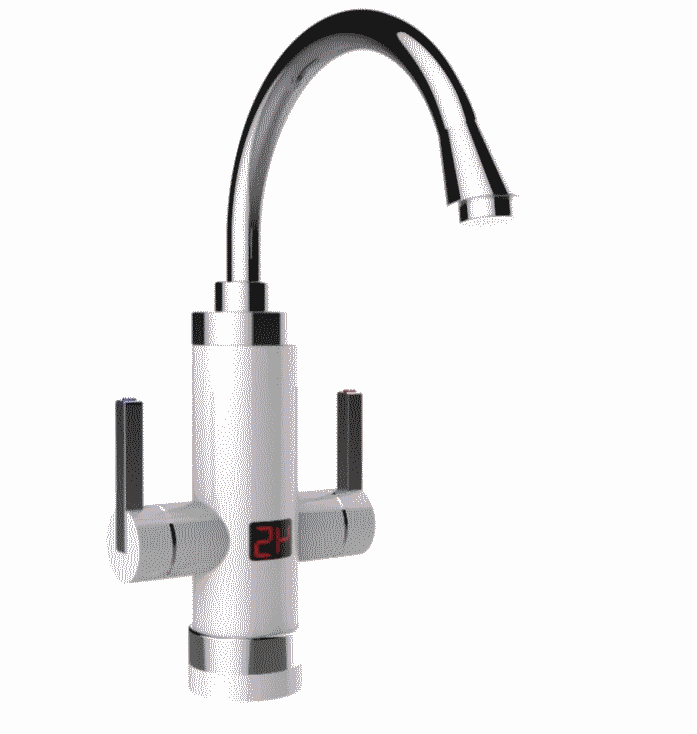
Main advantages
- Compactness. Takes up very little space. Located on the tap.
- Heating time. Depending on the power of the model, warming up lasts 10-30 seconds.
- Aesthetics. A large selection will allow you to choose a faucet to suit your interior. There are devices of different colors, glossy and matte, unusual shapes and original geometry.
- Easy installation. The technology is almost the same as when installing a conventional mixer. It differs in the need for a separate electrical cable and grounding.
- Electricity consumption, only when in use.
- Price. The price of an electric water heater per tap is less than for a full-size electric or gas instantaneous water heater, especially for a storage boiler.
Flaws:
- Bandwidth. The volume of heated water is 1-6 l/min. The performance of a gas heater is approximately 1.5-2 times higher.
- Network load. For installation in a room with old electrical wiring, a separate cable will be required.
Despite all the disadvantages, water heaters can be installed on a tap in the following cases:
If hot water is required periodically and in small quantities.
In case of unstable hot water supply, if there are short-term interruptions in the water supply.
For seasonal consumption, for example, for water supply in a country house.
Organization of hot water supply in a separate summer kitchen
In beauty salons, hairdressers
Gas
If a country private house or cottage is heated with gas, it is better to choose gas water heaters, as they are cheaper to operate. The most popular is flow-through. It has all the advantages of its electrical counterpart, but does not create a large load on the electrical wiring.
Unlike an electric instantaneous water heater, several hot water supply points can be connected to a gas appliance.
The downside may be tracking the device's status. These devices are sensitive to pressure fluctuations in the natural gas supply system

.To connect a gas instantaneous water heater in a private house or apartment, it is not enough to connect a water supply pipe. A gas supply pipe is required, as well as a ventilation system to remove combustion products.
An instantaneous gas water heater is not designed to store heated water. Its size depends only on the availability of heating equipment. A separate room (boiler room) is recommended for installing a gas appliance. Placement in non-residential premises with good ventilation is allowed.
Cumulative
Electrical
This is the most common and popular type of device. Choosing an electric storage water heater for an apartment can be considered the best option. especially when the hot water is turned off.
It not only heats the liquid to the desired temperature, but also keeps it hot for a long time, like in a thermos.
A storage boiler differs from a flow-through device by the presence of a tank for storing heated water. When hot water is consumed from the storage tank, it is replaced by cold water, which also heats up. From the boiler, water flows into the mixer.
Storage containers vary in capacity: from 10-30 liters to 150-200 liters. Containers with a volume of up to 100 liters are attached to the wall. Those that have a larger volume are installed on the floor and are designed for permanent operation.
Before choosing an electric water heater for an apartment, house or cottage, you need to calculate the amount of water consumed per family.

Electric storage
approximate calculations:
up to 15 l – quite enough for washing dishes and washing up
50-80 liters - for a family of three to wash dishes and take a shower. You can also fill the bathtub. But you will have to wait until it warms up after each family member has washed.
80-100 liters - approximately what is needed for a family of 4 people. The water in such a boiler will take longer to heat up.
100-150 liters is enough for 5 people. You can take a bath.
More than 150 liters - this capacity allows you to use water with almost no restrictions.
— When choosing a storage water heater, keep in mind that the heating speed depends on the amount of water in the tank. For the daily needs of one family, a system with average performance is sufficient. The time required to heat the vein to 60 degrees in the boiler ranges from 15 minutes to 1 hour.
Advantages of storage water heaters
- Durability;
- Compared to flow-through models, energy savings;
- Maintenance of all water points in the apartment;
- Simple control system. It is enough to set the required temperature, turn on the 220 network and ensure the water supply.
- Affordable price
Flaws
- Size. The storage tank is large. During installation, many are faced with the problem of lack of space for installation. In small apartments, this equipment is installed in the toilet, above the toilet cistern
- Heating duration.
- Monitoring the condition of the heating element. If the water has increased hardness. Scale forms on the heating elements and they fail faster. This can be solved by installing a water purification filter.
From gas
As an alternative to an instantaneous water heater, you can purchase a gas storage heater for a private home.
The only difference is that the water heater (storage) has a liquid tank. The water in the tank is heated in the same way, by burning gas. The heating temperature is controlled by a thermostat, which turns off the gas supply when the liquid reaches the desired temperature.
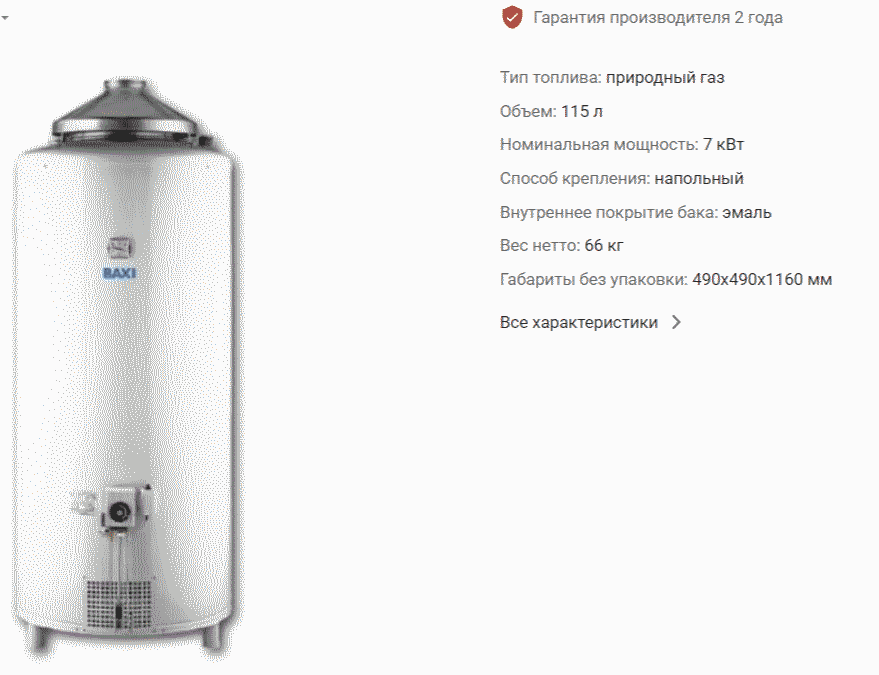
The advantage compared to flow-through is that there is always hot water in the system. And you don’t need to turn it on every time for heating, which ensures more economical use of gas.
Indirect heating equipment
Indirect heating devices do not have built-in heat sources. The water in the tank is heated from external sources. Most often, the source is liquid from the heating system, which, flowing through a heat exchanger (coil), gives energy to the water in the tank, thereby heating it
Thanks to the use of external coolants, choosing an indirect boiler for hot water supply at home will be an economical option, since it does not consume gas and electricity.
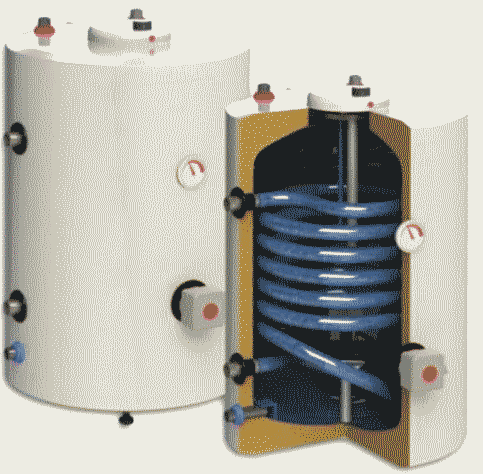
However, it should be taken into account that this type of device is associated with high cost. It is advisable to use an indirect heating boiler in large houses (if the number of family members exceeds 6 people), institutions, cafes, canteens and restaurants where significant consumption of hot water is expected.
Advantages of indirect heating boilers:
Low cost.
High performance.
Hot water comes straight from the tap.
Cools down slowly.
Simplicity of design.
Flaws
Bulky equipment.
Duration of water heating.
High price
DIY process
The following tools will be useful for the job:
- welding inverter;
- welding generating current from 15 amperes.
You will also need copper wire, which is wound around the core body. The device will act as an inductor. The wire contacts are connected to the inverter terminals so that no twists are formed. The piece of material needed to assemble the core must be of the required length. On average, the number of turns is 50, the wire diameter is 3 millimeters.
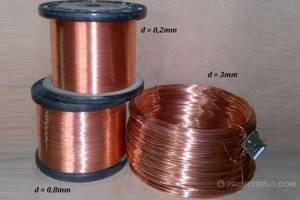
Copper wire of different diameters for winding
Now let's move on to the core. Its role will be a polymer pipe made of polyethylene. This type of plastic can withstand quite high temperatures. The core diameter is 50 millimeters, the wall thickness is at least 3 mm. This part is used as a gauge on which copper wire is wound, forming an inductor. Almost anyone can assemble a simple induction water heater.
In the video you will see a way to independently organize induction heating of water for heating:
First option
The wire is cut into 50 mm sections and a plastic tube is filled with it. To prevent it from spilling out of the pipe, you should seal the ends with wire mesh. Adapters from the pipe are placed at the ends, in the place where the heater is connected.
A winding is wound onto the body of the latter using copper wire. For this purpose, you need approximately 17 meters of wire: you need to make 90 turns, the pipe diameter is 60 millimeters. 3.14×60×90=17 m.
The pipe crashes into the pipeline. The heater is connected to the inverter. All that remains is to fill the device with water and turn it on. All is ready!
Second option
This option is much simpler. A straight meter-sized section is selected on the vertical part of the pipe. It should be thoroughly cleaned of paint using sandpaper. Next, this section of the pipe is covered with three layers of electrical fabric. An induction coil is wound with copper wire. The entire connection system is well insulated. Now you can connect the welding inverter, and the assembly process is completely completed.
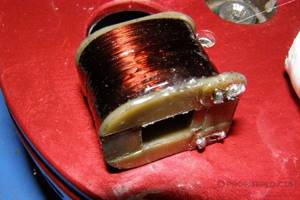
Induction coil wrapped with copper wire
Before you start making a water heater with your own hands, it is advisable to familiarize yourself with the characteristics of factory products and study their drawings. This will help you understand the initial data of homemade equipment and avoid possible errors.
Third option
To make the heater in this more complex way, you need to use welding. You will also need a three-phase transformer for operation. Two pipes need to be welded into each other, which will act as a heater and core. A winding is screwed onto the body of the inductor. This increases the performance of the device, which has a compact size, which is very convenient for use at home.
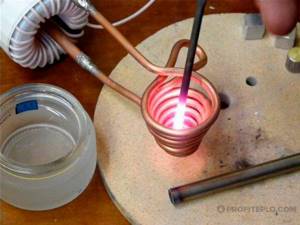
Winding on the inductor body
To supply and drain water, 2 pipes are welded into the body of the induction unit. In order not to lose heat and prevent possible current leaks, you need to make insulation. It will eliminate the problems described above and completely eliminate noise during boiler operation.
Which one to choose, flow-through or storage?
Instantaneous water heaters offered by manufacturers have quite high power. In addition, in most cases they are cheaper than storage ones, are easy to install and do not take up much space.
The process of heating the liquid occurs almost instantly as it passes through a heated tubular flow heater. And the volume of hot water produced by the device is not limited. The device takes only 1-2 minutes to heat 7 liters to 50 degrees.
A good option for a private house or apartment.
Without going into details of which is better and which is worse, it is only worth saying that the average power parameters of instantaneous water heaters range from 10 kW to 40 kW. This means that you will need a separate cable with a socket, and an additional circuit breaker must be installed in the distribution board. The device must also be grounded.
But even if these conditions are met, in a house or apartment with old electrical wiring, installing instantaneous water heaters is not recommended. Otherwise, all sorts of emergencies may arise.
Storage water heaters have a built-in reservoir that stores hot water. In flow-through systems, water passes through the device and is heated by direct contact with the heating element.
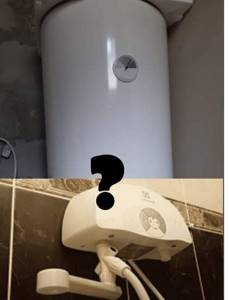
Flow or storage
When choosing a storage water heater, you need to understand what power the home electrical network is designed for and what volume of the tank is needed.
Storage devices of average power consume up to 3 kW, depending on the volume of the tank, while flow-type devices range from 6 to 27 kW.
With a tank volume of 15 liters, the power of the heating element will be about 1 kW, with 30-50 liters - 1.5 kW, with 80-100 liters - 2 kW or more.
200 liter storage water heaters are often equipped with powerful heating elements starting at 5kW.
The advantage of a storage water heater is the ability to maintain the required temperature and water pressure with many connection points, more than three. If your family is large and you need, for example, to use a shower, kitchen sink and toilet at the same time, this device will be the optimal solution.
Storage heaters do not put a large load on the electrical network.
In addition, when choosing a water heater, you should focus on performance, which depends on the pressure in the tank. The optimal figure for a family of three and several points of water consumption is 6-8 liters per minute.
It takes time to heat the water. It will take approximately 1 hour to heat 15 liters of cold water to 60° with a 1-1.5 kW heating element. It will take up to 3.5 hours to heat 100 liters.
Unlike flow-through systems, storage water heating systems. Capable of creating maximum pressure until the water supply in the tank runs out.
To summarize, we can draw the following conclusions. Each type of heater is good in its own way. And it solves the problem of heating water depending on the conditions in which it is intended to operate. Therefore, when choosing a device type, you must first take into account the specific installation location and intended use cases
Types of devices
When choosing a boiler for heating, many are interested in its two parameters. The first is the volume of the tank, the second is the electrical energy consumed.
Instantaneous water heater
A flow-through water heating boiler does not have a container designed for a large volume. It is designed so that the water consumed is heated instantly. There are two types used in everyday life:
- Electric - production takes place in a compact case, wall mounting. Water is heated as it passes through an electric heater.
- Gas - water flows inside the heat exchanger. A gas burner burns under it, which heats the liquid.
We recommend: Review of the Breneran long-burning stove with a water circuit: instructions for use
An instantaneous electric water heater intended for heating has the following device:
- Body - the material is metal or plastic, the outside is covered with a special coating for protection and decoration.
- Heat transfer tube - located inside the housing, most often has a spiral shape.
- The heating part is located in the heat exchange tube or in a separate metal glass.
- Flow meter - there is a reaction to the closing/opening of the faucet mixer.
- Electromagnetic starter - controls a magnetic starter and is a powerful electric heater.
- Thermostat - turns the unit on/off, regulates the supply of hot water based on the pressure power.
- Thermal fuse - necessary for emergency shutdown of the device.
| pros | Minuses |
| Light weight, compact parameters | Due to their complex manufacturing, their price is quite high. |
| It is possible to operate immediately as soon as it is turned on, since the water heats up quickly | High electricity consumption |
| Connection and installation can be done independently in an hour and a half | To connect, it becomes necessary to lay another network cable separately |
| All parts inside are made of metal that is not subject to corrosion |
Electric storage boiler
Electric storage boilers are most often used in everyday life. Externally they have differences, but the device itself is the same:
- The case is made of steel with a thickness of 0.8 millimeters. A polyester enamel coating is applied on top, serving not only as decoration, but also as protection.
- The tank is located inside the body, made of steel 1.2 millimeters thick, the outside is coated with corrosion protection. It has three types. The first is a heat-strengthened coating, used in inexpensive models. It is considered not particularly durable: the enamel can crack and crumble due to a sharp change in temperature. The second is glass ceramics, applied at high temperatures, very durable. The third is titanium coating, the most durable and strong, used on expensive models.
- Thermal insulation - minimum thickness is 20 millimeters, maximum - 40. It looks like a layer between the tank and the outer casing.
- Magnesium anode - designed to protect against rust. Installation takes place near the heating element and protects the tank and heating part from electromechanical corrosion.
- Heating element - located at the bottom of the tank.
- Thermometer - digital or mechanical. Located outside the housing, designed to control water.
- Thermostat - automatically turns on/off the heating element. Adjustment is manual or electronic.
- Indicator LED - connected to the thermostat, lets you know when the heating element is on or off.
- Water pipes are made of metal, end with a thread on the outside, and are connected to the water supply.
- Mounting Bracket - Used to mount the unit to the wall.
| pros | Minuses |
| A large assortment | Installation should only be carried out on a solid wall due to the heavy weight of the devices |
| Installation is simple, easy, completed in a couple of hours | Maximum service life is nine years, as corrosion resistance is reduced |
| Part replacement takes a maximum of one and a half hours | Due to the insulation, the parameters are quite dimensional |
| Low electricity consumption | Takes a long time to heat up (from half an hour to nine hours) |
| A thick layer of scale appears |
Gas or electric?
The advantage of gas boilers over electric storage water heaters is that they are small in size and easily fit even in a small kitchen.
A gas water heater is more expensive and requires a lot of hassle to get started. But after a while it will pay off and become more profitable than electric
th Electric water heater is safer, easier to maintain and install. Initially requires minimal investment.
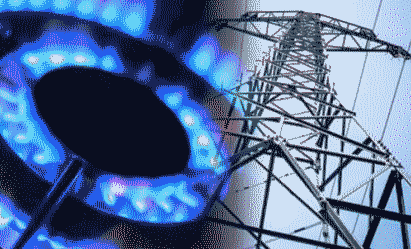
An instantaneous electric water heater has a relatively low cost, but is inferior to its gas counterparts due to uneconomical electricity consumption.
If the house does not have gas supply, the choice is obvious - electric.
For a large family, 4-5 people, it is more convenient to use an electric water heater; the difference in the cost of electricity compared to gas appliances will not be so significant.
Well, which one to choose, everyone must decide for themselves. Based on the possibilities and selection criteria.
Control system
Electronic control
The device can be controlled and protected using a microprocessor. There is an LCD screen (possibly with a touch panel).
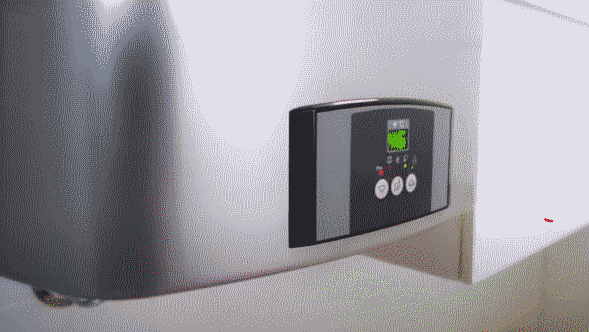
The required temperature regime can be set and adjusted using indicators and keys. In this case, the temperature can be set accurately, its value is displayed on the screen. Of course, this is more convenient, but repairs and purchase of such equipment will cost more.
Interesting fact! The price of a 30 liter flat electric storage water heater with mechanical control is on average 50-100% higher than with electronic control.
Simple mechanical thermostat
In simple models, a regular switch is installed, which can be in the form of a round regulator or a button.
The design is very simple, which ensures high reliability of the device
With its help, you can change the heating from 60 degrees to the desired degree value. It is impossible to set the exact temperature value; it will be displayed with an error of several degrees.
As a rule, these mechanical regulators are replaceable; you can often find an analogue in case of failure. Their replacement is simple and does not require the help of service specialists.
Tank coating material
Water heater tanks are made of metal. Metal that comes into contact with water is susceptible to corrosion. Therefore, tanks are made from materials that do not corrode or are coated with a special coating.
The anti-corrosion layer is made from components that are resistant to aggressive environments, including. Therefore, before choosing a water heater, pay attention to the material from which the tank is made and its internal coating.
For water heaters, the internal coating of the tank is made of the following materials:
- Enamel is fragile and can peel off from the walls of the container. But by adding special additives to the enamel, the same expansion coefficients are obtained as the steel from which the tank is made, so this coating does not crack when heated. The enamel coating is improving every day. You can also find water heaters in which silver ions are sprayed onto the enamel. Thereby. antibacterial and anti-corrosion properties increase.
- Glass ceramics differs from enamel in that it reduces the thermal conductivity of the container. A water heater treated with such material does not emit heat, therefore the water will cool more slowly. This will reduce energy consumption. Disadvantages: high sensitivity to point mechanical effects.
- plastic covering - thermoplastic tanks. They are generally the cheapest and although plastic can withstand high temperatures, their lifespan is much shorter than that of metal tanks.
- Titanium is reliable, but also the most expensive of all types.
- Stainless steel - in this case no protective coating is required. Stainless steel is resistant to corrosion and damage, and is not afraid of transportation. The warranty on such tanks ranges from 10 to 12 years. A model with a stainless steel tank is more expensive than one made of plastic, enamel or glass ceramics. The choice of such a water heater for an apartment is optimal.
The nuances of choosing the right model
Electricity is an expensive energy resource. If the boiler is selected incorrectly, you will have to pay huge electricity bills.
Therefore, it makes sense to pay attention to some nuances:
- functions . It is necessary to decide what functions the boiler should perform - only heat the house or additionally supply it with hot water.
- Technical parameters of the boiler. Be sure to take into account not only the heated area, but also the degree of its thermal insulation.
- Price . In many ways, the cost of heating devices depends on power, but that’s not all. Additional features can lead to a significant increase in the price of the model. Therefore, you need to clearly understand whether your budget allows you to overpay for convenience.
Even before you start looking for a boiler, you should find out how powerful it should be.
You can calculate the power based on average indicators: 1 kW of electricity is enough to heat a room of 10 square meters. with a ceiling height of up to 3 m. It turns out that a device with a power of 6 kW or more is suitable for heating a small house with an area of 60 m2.
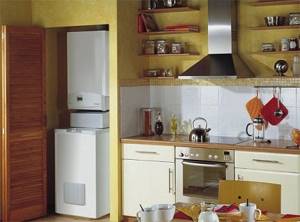
When purchasing an electric boiler, energy consumption is of fundamental importance. It’s better to overpay for a more expensive model, but save on its operation
It is advisable to take into account the degree of thermal insulation and buy a boiler with a small power reserve (20%). If the house is poorly insulated, it is better to choose a gas or solid fuel model, since heating with electricity will be too expensive.
Heating elements in electric water heaters?
Water heating is carried out using heating elements (tubular electric heater). They differ in the principle of operation; they are “dry” and “wet”.
The “wet” heating element is similar to a conventional boiler for heating water. It consists of a copper tube into which a nichrome spiral filled with a dielectric is mounted.
Its advantages
- easier to find a replacement in case of failure
- the price is cheaper.
Flaws:
- a layer of scale settles on the surface: the higher the water hardness, the larger it is.
- With a large layer, the heat release of the heater decreases, it begins to overheat and burns out.
If the housing of the heating element is damaged, it can continue to work, but there is a high risk of electric shock;
.
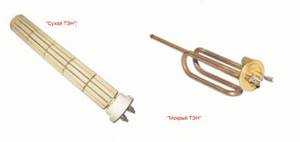
Water heater heating elements
“Dry” heaters do not come into contact with the liquid in the tank. They have different designs, but their common feature is that the heaters are installed in special tubes soldered to the flange. Or in a protective flask, also mounted on a flange, which is hermetically sealed at the bottom of the tank.
Boilers with “dry” heating elements have a long service life, even if they work with hard water.
Although scale also collects on the protective covers, it takes longer than when using open heating elements.
In addition, thanks to the reduction of galvanic corrosion, the internal coating of the tanks lasts longer
Preventative maintenance and descaling should be carried out every 2 years.
Advantages and disadvantages of the device
There are a lot of “advantages” of a vortex induction heater. This is a simple circuit for self-production, increased reliability, high efficiency, relatively low energy costs, long service life, low probability of breakdowns, etc.
The productivity of the device can be significant; units of this type are successfully used in the metallurgical industry. In terms of heating rate of the coolant, devices of this type confidently compete with traditional electric boilers; the water temperature in the system quickly reaches the required level.
During operation of the induction boiler, the heater vibrates slightly. This vibration shakes off limescale and other possible contaminants from the walls of the metal pipe, so such a device rarely needs to be cleaned. Of course, the heating system should be protected from these contaminants using a mechanical filter.
Constant contact with water minimizes the likelihood of the heater burning out, which is a fairly common problem for traditional boilers with heating elements. Despite the vibration, the boiler operates extremely quietly; additional sound insulation at the installation site is not required.
Another good thing about induction boilers is that they almost never leak, unless the system is installed correctly. This is a very valuable quality for electric heating, as it eliminates or significantly reduces the likelihood of dangerous situations occurring.
The absence of leaks is due to the non-contact method of transferring thermal energy to the heater. Using the technology described above, the coolant can be heated almost to a vapor state.
This provides sufficient thermal convection to encourage efficient movement of coolant through the pipes. In most cases, the heating system will not have to be equipped with a circulation pump, although it all depends on the features and design of the specific heating system.
Sometimes a circulation pump is necessary. Installing the device is relatively easy. Although this will require some skills in installing electrical appliances and heating pipes. But this convenient and reliable device has a number of disadvantages that should also be taken into account.
For example, a boiler heats not only the coolant, but also the entire working space surrounding it. It is necessary to allocate a separate room for such a unit and remove all foreign objects from it. For a person, staying in close proximity to a working boiler for a long time can also be unsafe.
The device requires electricity to operate. In areas where there is no free access to this benefit of civilization, an induction boiler will be useless. And even where there are frequent power outages, it will demonstrate low efficiency. If the device is handled carelessly, an explosion may occur.
If you overheat the coolant, it will turn into steam. As a result, the pressure in the system will increase sharply, which the pipes simply cannot withstand and will burst. Therefore, for normal operation of the system, the device should be equipped with at least a pressure gauge, and even better - an emergency shutdown device, a thermostat, etc.
All this can significantly increase the cost of a homemade induction boiler. Although the device is considered virtually silent, this is not always the case. Some models may still produce some noise for various reasons. For a device made independently, the likelihood of such an outcome increases.
Power
How to choose an electric water heater by power? Power consumption is a parameter on which the efficiency of the heating element depends. The general rule is true for absolutely all devices - the higher the power, the faster the water heats up.
The power of the tank determines the cost of electricity and how quickly the water will heat up. Typical power is 1-6 kW. The most common electric water heater is the option with a power of 1.5-2 kW.

For instantaneous and storage water heaters, the power ranges are significantly different. Flow-through - due to the nature of the system, it consumes more electricity than storage.
The power of small devices with a water flow rate of up to 3 liters per minute can range from 3 to 5 kW. When taking a shower, we use about 7-9 liters of water per minute, and at the stated maximum temperature of 65 degrees per 3 liters we get slightly warm water.
Models with a power of 8 kW are ready to heat up to 6 liters of water in 20 seconds. The most powerful ones require connection to a three-phase 380 volt network. As a rule, the threshold for electrical appliances is 30 kW.
What will help you save on heating?
There are several devices that help reduce energy consumption and reduce the cost of heating a home:
- Thermostats . Heating boilers equipped with thermostats do not overheat the rooms, but at the same time maintain the set temperature.
- Programmers . “Smart” boilers regulate the room temperature according to a specific schedule. Although the boiler itself is constantly running, the heating element consumes electricity only 34% of the time. Read more about installing a heating system in a smart home here.
- Multi-stage power regulators . Thanks to automatic regulators, energy resources can be used extremely rationally.
- Microprocessors . The devices smoothly regulate the power of boilers, and some devices can even be controlled remotely - from smartphones or other gadgets. Such models are expensive, but worth the money spent.
The energy consumption of an electric boiler is significantly affected by the presence or absence of a circulation pump.
If it is not included in the model, it is advisable to purchase it separately and connect it to the heating system.
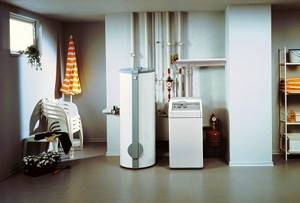
If there is a possibility that the house will be left for some time during the cold season, it is better to choose a model with a coolant freeze protection system
When purchasing a boiler for a country house or cottage, you should pay attention to antifreeze protection systems for the coolant.
Tank volume for heating water
Volume water heater for a house or apartment. Resolving this issue should be a priority. Many people make the mistake of buying a device with a large capacity, following the idea of “bigger is better.”
But in reality, you will end up with unjustified energy consumption, since the device will spend more time heating water than a similar device of a smaller size. In addition, the dimensions of such a device will take up more space, so focus on your needs.
Let's look at approximate values that should be used as a guide when choosing the size of the device. They depend on how many people will use the hot water.
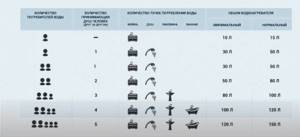
- The most compact models with a volume of up to 30 liters are perfect for a summer house, small kitchen or bathroom. It's hard to think about taking a shower, but doing the dishes and laundry is possible...
- Choosing a water heater with a capacity of 50-80 liters will provide hot water for a married couple..
- For a family of 2-3 people, a boiler with a volume of 80-100 liters is suitable.
- A family of four is recommended to purchase a device with a capacity of 100 to 120 liters.
- For a family of 5 or more people, you can purchase a device with a larger capacity - 150 liters or more.
- For a large family of 7-8 people, if this is a private house, it would be wiser to choose an indirect heating (storage) water heater. Among floor-standing models, you can choose a device with suitable power that can provide hot water to the whole family.
Dimensions
Depending on the volume of the tank, storage water heaters can be either compact or very large. In the first case, they can be mounted on the wall or hidden under a kitchen cabinet drawer. In the second situation, it may be necessary to allocate space for a separate room if it is a private house.
The larger the volume of the water heater, the larger its dimensions. Basically, the diameter of the tank is 45-55 cm. But the height depends on the volume.
Approximate Dimensions
- Volume 50 liters - 50-60 cm.
- 80 liters - 75-85 cm.
- 100 liters – 100-115 cm.
- 150 liters - 140-160 cm.
The depth of the flat water heater is approximately 30 cm. But due to the decrease in size in depth, the height increases
The diameter of the slim water heater is 35-38 cm. They are very convenient to install in narrow niches. But as the depth decreases, the height increases.
- with a volume of 50 liters the height will be 80 cm.
- The 80-liter has 115 cm.
- And with a volume of 100 liters – 140 cm.
Water heater shape
Depending on the storage form, boilers are: cylindrical and square (flat).
Cylindrical
When choosing a water heater for an apartment, most people choose cylindrical models for vertical placement.
They have the following advantages:
- The devices are compact and do not take up much space;
- The cylindrical shape has maximum contact area.
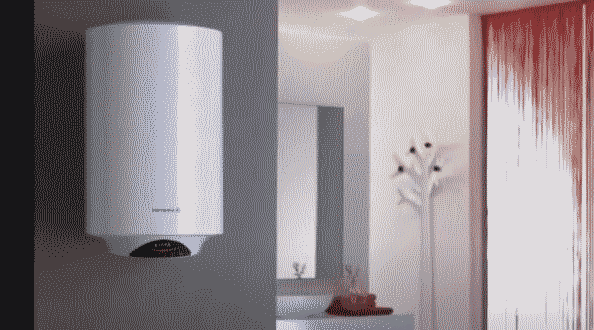
The disadvantages of thin units include
- the fact that some manufacturers, in order to increase the volume of the internal tank without increasing the outer diameter, reduce the thermal insulation layer. As a result, the liquid in the tank cools faster and the device is forced to turn on more often.
There are also narrow devices in the shape of a flattened cylinder, the so-called slim water heaters (from the English “slim” - thin). They differ in diameter (from 38 cm and less) from standard units, which have a circumference of 45-52 cm. At the same time, in order to increase capacity, the manufacturer increased their height.
The slim unit is very convenient in small apartments of an old building, where there are very cramped bathrooms and limited space in the kitchen. This parameter is convincing for choosing a small electric water heater for such an apartment.
It can operate with the same efficiency as a standard one and has the same capacity thanks to the conversion of usable space into height.
Rectangular (flat)
Models of flat (rectangular, square) shape do not differ in performance from cylindrical ones.
The flat-shaped storage water heater takes up little space, has a nice design, and fits well into the interior.
Since these devices are hidden in kitchen or bathroom cabinets, you can easily select the thickness of the device you need.
There are also models for horizontal placement. This placement allows you to make the most of free space if it is limited to a small room.
The cost of such water heaters is higher than vertical ones.
Introduction to flat-plate solar collectors

A homemade structure is a flat wooden frame with a bottom (wall) attached to the bottom. An absorber is placed there - a light-absorbing panel. In most cases, this role is played by a sheet of metal. It is connected to a tubular manifold: To make the device as efficient as possible, both elements are connected with clamps, welding or soldering, with a continuous seam.
The circuit consists of vertical tubes of small diameter, which in the upper and lower parts are connected to thicker pipes that serve to supply and extract heated coolant. The holes for liquid inlet/outlet are located diagonally. This method guarantees complete heat removal. Non-freezing solutions are used as a coolant: for example, antifreeze.

The absorber panel is covered with light-absorbing paint, the structure is covered with glass or other transparent material on top, and the box itself is protected by providing high-quality thermal insulation. The insulated, completely sealed design prevents even minimal heat loss. Since it is reliably protected from precipitation, the effect of a thermos is created inside.
The operating principle of a homemade device is quite simple.
- The non-freezing liquid, heated in the solar collector, passes up the tubes, then enters the water intake branch and goes into a container designed to accumulate heat.
- Thanks to the heat exchanger located in a high-quality insulated storage tank, the antifreeze transfers heat to the water when moving along a spiral coil.
- Then the spent, cooled liquid again enters the lower part of the water heater circuit, where it is subsequently heated again.
- The water that rises to the surface, heated in the tank with antifreeze, is taken away for the needs of hot water supply.
- It is replaced by water entering the storage tank from the connected water supply.
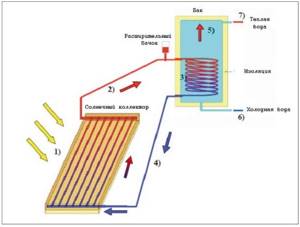
The movement of liquid is ensured by different densities: hot ones have less density. For a device that operates as a heater for a heating system, an additional circulation pump is required, which is low-power but quite effective. In this case, the tank can be located anywhere, even in the basement. If the circulation of the coolant is natural, then the storage tank must be located higher than the upper part of the heat exchanger. The constant movement of antifreeze and the presence of a battery tank makes it possible to accumulate liquid during daylight hours and use it in the evening or at night.
Economical
In storage water heaters, the main parameter responsible for efficiency is the daily heat loss, measured in kWh per day. It shows the amount of energy used to maintain the water temperature at 65 degrees for 24 hours.
It is worth noting that horizontally installed water heaters have higher heat losses and are less economical compared to vertical ones.
Some models have an economical mode that maintains a certain water temperature (not the maximum) with minimal energy consumption.
Additional features when selected
Some useful tips to help you choose a reliable and easy-to-use water heater:
— A layer of insulation is laid between the walls of the external and internal tank. The thicker it is, the longer the water will be hot. The recommended insulation thickness is more than 3.5 cm.
— The indicator light helps to determine the operation of the boiler.
— It’s good if there is accelerated heating of water.
— It is better to choose a water heater with a thermostat and heating control so that the device does not overheat.
— If the heater is needed for hot water supply to the cottage, the frost protection function will come in handy.
— A timer switch allows you to heat the water in the boiler at a specified time.
— The degree of protection against moisture is IP23, but for wet rooms (bathroom or sauna) you should choose a device with a higher degree of protection.
— You should also take into account the minimum and maximum pressure for instantaneous water heaters.
-Presence of magnesium anode. It is usually located with an electric heating element, but can sometimes be installed separately.
The magnesium anode performs two main functions:
- protects the inner surface of the tank from corrosion;
- softens scale that forms on the heating element rods.
In this case, the magnesium anode is gradually destroyed. Therefore, to replace the heating element, remove scale and other procedures, periodic maintenance work is provided, the procedure for which is described in the user manual.
Additional important functionality
- A layer of thermal insulation for storage models is not a whim, but a necessity. It helps the water stay warm longer. The instructions indicate what kind of insulation and what thickness was used by the manufacturer. The more expensive the unit, the thicker it is: 40-50 mm versus 10-20.
IMPORTANT! The ideal layer is 70 mm. You can insulate the boiler yourself, using soft or hard insulation, or spraying polyurethane foam sealant and foam.
- High-quality units always have overheating protection installed. When approaching a critical point, special sensors turn off the boiler.
- A timer is needed to program the time to turn on and off water heating. Will help you warm up the liquid before you wake up.
- IP stands for Ingress Protection Rating and indicates the degree of security of the device. It is written in the characteristics of the device in the form of two numbers - two degrees. The first shows the user the degree of protection against dust, the second - water. The degree is indicated from 0 to 8, where 0 is no protection, and 8 is the strongest protection (at which even a long stay of the device in water will not harm it).
Installation features
Installation also depends on the type of model: horizontal or vertical.
Structurally, they differ from each other, and you cannot hang a vertical water heater horizontally and vice versa!
In a horizontal water heater, liquid enters through the lower pipe, and through the upper pipe, boiling water comes out under pressure to the hot water tap. With active water intake (due to increased mixing of water with temperature differences), the temperature of the already heated liquid will drop faster.
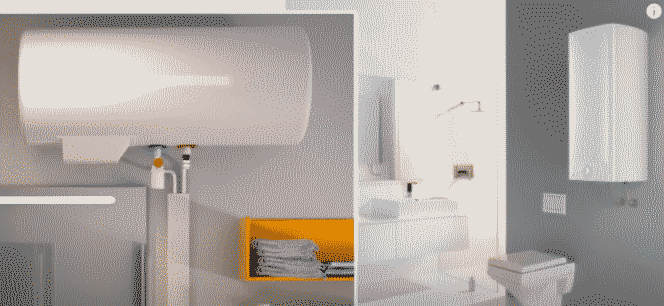
Horizontal and vertical water heater
Vertical works a little differently: here the contact of cold and hot water is significantly reduced. In addition, the consumer receives more hot water thanks to the divider installed at the bottom. Which does not allow cold water to rush upward, but directs the flow downward, thereby preventing the water temperature from rapidly decreasing.
There are vertical and horizontal models on sale. According to the manufacturer, they can be installed in both directions. The operating principle of such models is closer to horizontal models.
Design features and operation of the heat generator
To organize individual heating, a transformer consisting of two windings can be used as an induction heater for this system:
- Primary.
- Secondary short-circuited.
Vortex flows here are formed in the internal component. They direct the resulting electric field to the secondary circuit. It is he who performs the simultaneous role of a housing and a heating element for the coolant. With an increase in the density of eddy currents that are aimed at the core, its entire surface initially begins to heat up, and then the entire element.

An example of installing an induction current water heater for heating
For the supply of cold water and the outlet of heated coolant, induction boilers are equipped with two pipes.
For those who want to make such equipment with their own hands, you need to provide that:
- The lower pipe is mounted on the inlet main section;
- The upper one is on the supply section of the pipeline.
How the system works
The heat generated by the boiler is transferred to the coolant circulating in the heating system. Due to hydrostatic pressure, heated water enters directly through the supply pipe into the general heating system and is constantly removed by pumping coolant into it. Therefore, the possibility of equipment overheating is completely excluded here.
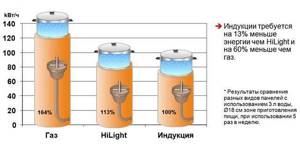
Comparison of energy consumption of an induction water heater with others
Constant vibration during operation of the induction system prevents the formation of scale and its hard deposits on the internal walls of the pipeline. Induction heaters do not have standard electric heating elements, so the likelihood of costly breakdowns is reduced to zero. In addition, there are no detachable connections that could threaten unplanned and unpleasant leaks. A positive feature of this boiler is the absence of noise during operation, which allows it to be installed in any residential premises.

